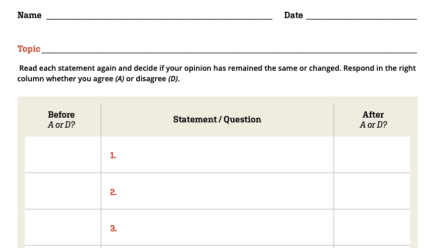Download a Graphic Organizer
An anticipation guide is a strategy that is used before and after reading. It can activate students’ prior knowledge and build curiosity about a new topic as well as evaluate how their perception of understanding of a topic has changed after reading or learning more about it.
Before reading a selection, students respond to several statements that challenge or support their preconceived ideas about key concepts in the text. This helps to stimulate students’ interest in a topic and sets a purpose for reading. Anticipation guides should be revisited after reading to evaluate how well students understood the material, correct any misconceptions, and discuss new ideas and connections students made.
Why use anticipation guides?
Anticipation guides are genuinely loved by teachers because they engage all students in the exploration of new information by challenging them to critically think about what they know or think they know about a topic and how their ideas maintain or change after learning more. In doing so, anticipation guides set a purpose to the reading, even for those students who initially may not be engaged by the topic.
How to create and use the strategy
There are several ways to construct an anticipation guide for middle and high school students. Most include the following steps (Duffelmeyer, 1994):
- Download our Anticipation Guide template (fillable pdf) to use.
- Consider what beliefs your students are likely to have about a topic.
- Write general statements that challenge your students’ beliefs.
- Require students to respond to the statements with either a positive or negative response.
- Create space for students to return to the guide after reading to reevaluate their thinking.
Strategy in action
Take a look at this example anticipation guide: Hunger Games. Notice how the teacher used statements related to overarching themes within the text instead of events. Getting students to connect to themes is often a powerful way to engage them in a new topic or text. Now, let’s listen to a middle school science teacher discuss how she uses anticipation guides with her students.
Tips for Success
- Have students complete the anticipation guide before reading and leave time to revisit it after reading. Students can work by themselves, in pairs or small groups but they should be prepared to discuss their ideas and reactions with the whole class.
- Remember, you want to activate students’ critical thinking about the topic, so dig deeper than students’ answers and encourage them to explain their reasoning or justifications.
- Have students read the text with their anticipation guide responses fresh in their minds so they can react to the text as they read. Encourage students to mark or write down where the text supports their initial reaction to statements, or causes them to rethink those reactions.
- Have a class discussion after reading. Ask students if they changed their position on any of the statements. Encourage students to share how they reacted to the text, given their initial responses captured in the anticipation guide. Make sure students share examples from the text where their initial responses were either supported or challenged.
